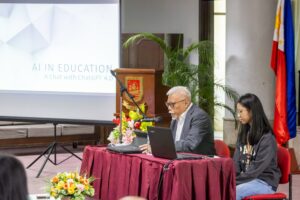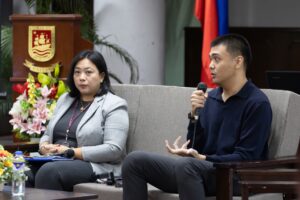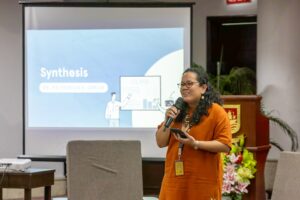By Za Elises
Faculty members of the University of Asia and the Pacific gathered on April 30 at the Telengtan Hall for a half-day colloquium titled “AI-Powered Pedagogy: Rethinking Teaching, Research, and Learning,” organized by the Center for Teaching and Learning (CTL), the University Research Office (URO), and Human Resource Management (HRM).
The event brought together teachers across disciplines to engage in conversations about the promise, the complexity, and the lived realities of using artificial intelligence (AI) in the academic context. Through a mix of keynote insights, panel exchanges, and an exploratory workshop, the session aimed not only to introduce tools but also to deepen reflection on the role of AI in shaping how faculty think, teach, and learn.
In his opening message, Dr. Dean Mejos acknowledged the mix of excitement and apprehension many faculty feel when engaging with AI. He noted that for some, the hesitation may come from guilt, pride, or even fear of being replaced. But he reminded everyone that AI, like any tool, gains value depending on how it’s used and who uses it. Drawing from personal experience, he shared how he had used ChatGPT to summarize and organize his thoughts while writing a research paper. It was helpful, he said, but never a replacement for his own thinking. The goal of the day, he emphasized, was to experience AI firsthand—not just hear about it—and to consider its ethical dimensions alongside its practical uses.
A Philosophical Lens on Artificial Intelligence
Dr. Jose Maria Mariano delivered the keynote presentation, offering a philosophical approach to AI in education. He began by recounting a conversation he had with ChatGPT, during which the AI stated: “I am not self-conscious.” He responded by asking how it could use the pronoun “I” without self-consciousness. This small paradox, he explained, opened up broader questions about the nature of intelligence and how we define personhood.

Dr. Mariano proposed that rather than educators merely applying AI to their teaching, it may be more fruitful to view education from the vantage point of AI itself. He argued that AI challenges us to confront what it means to know, to think, and to be human. It should not simply be treated as a tool but as a mirror, forcing us to examine our own minds and teaching practices.
On-the-Ground Insights from Teaching and Research
The panel discussion, moderated by Dr. Mejos, was divided into two parts: AI in Teaching and AI in Research. Speakers came from diverse backgrounds, bringing in voices from undergraduate instruction, corporate training, and faculty research, and postgraduate research.

Mr. Ramon Villareal (SLG) shared how his journey with AI began out of curiosity and necessity— balancing responsibilities as a teacher, a family member, and an entrepreneur. He described using ChatGPT for lesson planning and administrative support and highlighted the importance of modeling responsible AI use for students. One of his key messages was that AI should help us “meet students where they are, but not leave them there”. He particularly described a class activity where his students discussed and reflected about Martial Law with the help of ChatGPT, learning not just content but also how to evaluate and challenge sources.
Ms. Carminia “Minnie” Guizano (CORE), coming from the corporate training sector, discussed the challenge of making academic materials relevant to specific industries. She shared how AI, particularly Gemini and ChatGPT, helped her craft customized case studies for banking professionals. However, she was also clear about maintaining rigor — comparing AI use to using a calculator only after one has mastered long division. She emphasized transparency, continuous training, and the need to strike a balance between AI-assisted efficiency and deep human judgment.
Dr. Noemi Torre (SSE) spoke about her initial hesitations around AI, particularly regarding ethics. Eventually, she began using Gemini to summarize dense research materials and found value in using Excel-based data analyzers. For her, the key was always intentionality: “The prompt should come from us.” AI, she said, can serve as a helpful assistant — but it should not drive the thinking.
Mr. Roshan Uttamchandani (SCM), a PhD student and faculty member, brought in the perspective of someone straddling both academic and student roles. He described his workflow to the likes of an “inverted research,” using AI to help back up claims he already drafted. He also uses it to translate texts and overall manage his time more efficiently. He noted that while AI can be a great time-saver, it also comes with risks like hallucinations, which he emphasized must always be checked with proper validation.
Hands-On with AI Tools
The latter part of the session featured a 30-minute workshop, giving faculty a low-stakes environment to try ChatGPT directly. Participants brought syllabi and sample student work, and worked through four guided tasks:
- Gathering updated references using AI-powered academic search tools
- Generating assessments from uploaded articles or AI-sourced materials
- Synthesizing literature for those working on research writing
- Reviewing student writing for clarity, structure, and formative feedback
The goal was not to evaluate output quality but to reflect on what AI could realistically support and where human judgment remains irreplaceable. The optional reflection that followed asked participants: Where in your teaching or research do you see AI being most helpful moving forward?
AI and the Call for Intellectual Autonomy

In her closing synthesis, Dr. Pia Patricia K. Garcia reflected on the individuality of each speaker’s engagement with AI. No two approaches were alike, and that in itself was telling: AI doesn’t have one universal use—it becomes meaningful in how it’s used by people. She raised the enduring question: What is education for? Is it merely about accuracy and productivity, or is it about cultivating something deeper, like wisdom, solidarity, and excellence?
Dr. Garcia imparted a framework for intellectual autonomy, which included the ability to think independently, evaluate sources critically, and seek truth with discernment. She acknowledged that while AI could have easily written her synthesis (especially since she had been “fed” prompts by the organizers), what it could not offer was the very reflection and human judgment she just demonstrated.
Her final provocation stayed with many participants: Can AI teach students to be wise? Can it teach them solidarity? Can it teach them what excellence truly means? Or will they only learn these things from educators who embody them?
The event succeeded in sparking thoughtful conversations, revealing both opportunities and limitations of AI in faculty work. It moved beyond tool demonstrations to encourage critical engagement with what it means to teach and learn in an AI-infused world. As UA&P continues to shape its institutional response to AI, this colloquium serves as a key moment—grounded in experience, dialogue, and shared questions about the future of education.
Leave a Reply